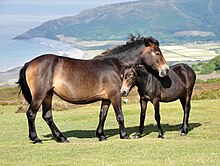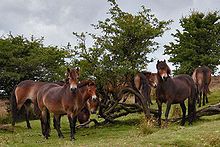Exmoor pony
| Exmoor pony | |
|---|---|

Exmoor ponies in winter fur |
|
| Important data | |
| Origin: | Exmoor |
| Main breeding area: | England |
| Distribution: | endangered breed |
| Stick measure : | up to 130 cm |
| Colors : | Duns and bay tones with flour mouth but no other markings |
| Main application area: | Children's pony, riding and farm horse, nature conservation |
The Exmoor pony is a medium-sized English pony breed. It is the most pristine and wild horse-like of the British small horses ; some herds still roam freely in the moors of South West England (e.g. Exmoor National Park , a wild animal stud farm ). Claims that Exmoor ponies have a seventh molar , which other horse breeds do not have, are based on a misinterpretation.
Background information on horse evaluation and breeding can be found under: Exterior , interior and horse breeding .
Exterior

Because of its phenotype, the Exmoor horse is considered by some researchers to be particularly close to the European wild horse . The Exmoor pony has a stocky, sturdy build. The fur color of the Exmoors is black-brown , which can range in shades from beige-brownish to dark brown-black. Most Exmoor horses, however, are colored red-brown or hazel-brown. Brown is a proven coat color for European wild horses. It would be relevant whether the European wild horses also had the Falb gene, which has not yet been genetically identified, or not. If the basic color is brown, the folds give a sand-colored tone like that of the Przewalski horse , and if the basic color is black, a mouse-gray color similar to that of the Konik . Consequently, brown, black, sand-colored and mouse-gray colors could have occurred in the European wild horse. Exmoor horses do not have the lightening fallow gene. A lack of fallow in the Western European Exmoor horse could be understood as an adaptation to wooded terrain in Central and Western Europe, which could have favored a darker color. The Exmoor horse, like all wild horse representatives today, has the pangare gene, which causes a light underside of the body and a white flour mouth . The legs become very dark towards the toes, and there is often a fine line of eel .
As a robust horse, the Exmoor horse is particularly tough and resistant to many horse diseases. The winter fur of the Exmoor pony consists of a soft, woolly undercoat and a longer, oily, water-repellent upper fur. As a further adaptation to the weather conditions of the British climate, the eye bulges present in some of the original ponies, which protect the eyes from rainwater and snow, are considered.
interior
The Exmoor pony is tough, sturdy, and healthy. Even if they sometimes show their individuality, they are generally friendly towards people and are attentive and willing to deal with them. In contrast to many other breeds, Exmoor ponies are shy when kept extensively and avoid humans. Others, such as Koniks, are very trusting, even if they have spent their entire lives in natural areas, which can lead to conflicts with people. Exmoor ponies also show a strong herd instinct when fleeing and sometimes form a defensive ring around the foals if they feel threatened while Koniks disperse.
history
As early as the Pleistocene , wild horses were used as food for people in Great Britain. Their remains are common in Ice Age sites. It is currently unclear whether wild horses disappeared from Great Britain during the Mesolithic and only came back to the island as domestic horses, or whether they survived continuously.
Genetic studies contradict the view that the Exmoor pony is a surviving form of Britain's wild horses. They share mDNA with several other domestic horse breeds, and their Y chromosome is identical to that of most other domestic horses.
What is certain, however, is that the Exmoor pony is the only largely uncrossed population of a wild horse type that was once widespread across Great Britain and can be traced back to at least 1086, the time of William the Conqueror , which is why the Exmoor pony herds as the longest traceable wild horse populations in Europe.
In historical times the horses were considered shy and were hunted. Their meat represented an important livelihood for many residents. Typical was a small, sturdy build not exceeding 130 cm at the withers, with a beefy head and short, bushy mane. The color was predominantly dark brown or black, with a light underside of the body and a flour mouth .
Over time, the ponies were no longer just hunted, but also tamed and bred by farmers. Due to their strong stature, they have proven themselves as draft animals. During the 19th and 20th centuries, they were crossed with horses from the mainland in many places, so that many local pony breeds lost their original appearance. By 1900 native British horse breeds still showed strong resemblance to one another. At that time ponies from North Wales , the Hebrides , Welsh ponies , the Dartmoor pony and the now extinct Galloway pony (from which the fur pony emerged) were as good as indistinguishable from today's Exmoor pony . Horses from the Faroe Islands can also be traced back to such ponies. Genetic findings imply a northern pony group, which includes other northern pony breeds such as the Shetland pony and the fjord horse , which also indicates a common origin.
Only in Exmoor there was very little mixing, so that the original wild horse type could be preserved there. Crosses with other races, v. a. the English thoroughbred , were carried out, but since their results were usually much worse with harsh winters, they were often given up. Accordingly, the influence of other breeds in the Exmoor pony remained low. This can be seen, among other things, in the breed's strikingly homogeneous appearance.
During the Second World War , the number of Exmoor ponies fell sharply. Around 50 survived, including only 6 stallions. This genetic bottleneck is blamed for a significant loss of genetic diversity within the Exmoor pony; so there used to be a black variant; There is also historical evidence of greyish-white Exmoor ponies with dark legs, which probably go back to interbreeding with other breeds.
In 1921 the Exmoor Pony Society was founded with the aim of preserving the Exmoor purebred pony. In 2010 the worldwide population of the Exmoor pony was estimated at around 800 animals. Some populations live wild or semi-wild, twelve herds alone in Exmoor.
use
The Exmoor pony is strong enough to carry a full-grown person, but is mainly used as a children's pony. This original horse is also used in nature conservation . Since the grazing influence of large herbivores contributes to the preservation of open areas with their biodiversity ( mega- herbivore hypothesis ), robust animals such as the ex-bog horse and the like are used. a. Used by the Working Group on Biological Environmental Protection (ABU) or the Stichting Taurus half-wild living in grazing projects. They also support the preservation of the natural and cultural landscape in the Hutewald project in the Solling-Vogler Nature Park . In addition, the Exmoor is proposed as a replacement for the extinct European wild horse in the wild.
See also
Web links
- German Exmoor Pony Society V.
- The Exmoor Pony Society
- Exmoor-Pony Germany e. V. (German)
- Information at Hannover Zoo
Individual evidence
- ↑ a b c d Margret Bunzel-Drüke, Carsten Böhm, Peter Finck, Gerd Kämmer, Rainer Luick, Edgar Reisinger, Uwe Riecken, Johannes Riedl, Matthias Scharf, Olaf Zimball: "Wilde Weiden". Practical guide for year-round grazing in nature conservation and landscape development. 2nd Edition. Working group for biological environmental protection in the Soest district, Bad Sassendorf-Lohne 2009, ISBN 978-3-00-024385-1 .
- ↑ a b c d e f g h i j k l m Baker, Sue, 2008: Exmoor Ponies: Survival of the Fittest - A natural history.
- ↑ Melanie Pruvosta, Rebecca Bellone, Norbert Benecke , Edson Sandoval-Castellanos, Michael Cieslak, Tatyana Kuznetsova, Arturo Morales-Muñiz, Terry O'Connor, Monika Reissmann, Michael Hofreiter, Arne Ludwiga: Genotypes of predomestic horses match phenotypes painted in Paleolithic works of cave art. In: Proceedings of the National Academy of Sciences . Vol. 108, No. 46, 2011, pp. 18626-18630, PMID 22065780 , doi : 10.1073 / pnas.1108982108 .
- ^ Tadeusz Jezierski, Zbigniew Jaworski: The Polish Konik. Die Neue Brehm-Bücherei Vol. 658, Westarp Sciences, Hohenwarsleben 2008
- ↑ Jansen et al. 2002: Mitochondrial DNA and the origins of the domestic horse
- ↑ Cieslak et al. 2010: Origin and History of Mitochondrial DNA lineages in domestic horses
- ↑ Wild horses for Europe - which breed is the best?

